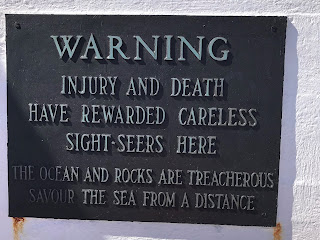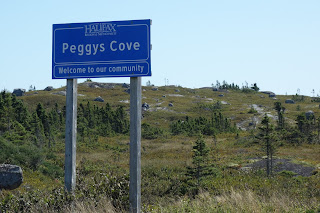Before reaching the "Rapids", we stopped to enjoy a couple of donuts from Canada's famous Tim Horton's. The reversing rapids are a unique phenomenon created by the collision of the Bay of Fundy and the Saint John River. The Bay of Fundy has the highest tides in the world - from 11 feet to an incredible 53 feet! At low tide the river empties into the bay causing a series of rapids and whirlpools. As tides rise they slow the river current for a brief period called slack tide. The Bay's tides continue to rise, gradually reversing the flow of the river; rapids form again, peaking at high tide. It's not much to see unless you are there twice at precise times of the day when you can witness the flow of water in opposite directions. But we could see confusion in the water as the levels in the river evened out and didn't seem to know which way to flow.
We walked to the Carleton Martello Tower which we had hoped to tour, but was closed due to renovation. Built by the British for the War of 1812, this circular stone fort played a crucial role in the defense of Saint John and its harbour. It is just one of 16 such structures originally erected across Canada. It features a restored powder magazine, soldiers’ barracks and other exhibits. A superstructure dating from WWII portrays the tower’s final function as a fire command post. A cemetery was located near the tower. From the tower, we could see our ship in port and other nice views of the bay.
We returned to the historic old town district and walked the "Loyalist Trail" starting at Market Square near our ship. With markets and parks to historical theaters and churches, we got a good overview of the charming Saint John.
There were beautifully painted colorful fish statues all around the city. We ended our day by sampling some Canadian "Poutine" before climbing aboard our ship and resting our weary legs. Sadly, I wasn't a big fan of the gravy and cheese curd covered fried potatoes. I really prefer my fries to be crisp and crunchy.
We decided to rent a car on Monday, September 9, 2019, so that when we arrived in Halifax, Nova Scotia, we could drive out to Peggy's Cove. It was a pretty drive, with lakes and rocky hills appearing around every bend. I couldn't have imagined a more perfect small fishing village with it's classic red and white lighthouse set upon the rocky shoreline. It was a popular destination! Everywhere I looked, another postcard picture appeared in my camera lens.
The Lighthouse was perfectly perched on top of a rocky hill overlooking the ocean. But with the busloads of people scrambling for the perfect shot, there wasn't a chance we'd get a photo without random people in it. It was still a lovely scene, nonetheless.
Lobster rolls seemed to be synonymous with Peggy's Cove, so we couldn't leave without enjoying that succulent buttery seafood for ourselves. The sun warmed our spirits as the lobster warmed our souls. Ahhh, simple pleasures!
We drove back to Halifax and returned the rental car. The Halifax Citadel was just up the hill, so we decided to purchase tickets and check it out. It was founded in 1749 as a strtegic base for the British Royal Navy. The citadel now reenacts the lives of British troops lived here in 1869, when Queen Victoria reigned over the two-year-old nation of Canada. Several rooms in the barracks had been made into a museum.
All around the fort were displays showing how things were done while living in this military base. Various flags were hoisted onto tall masts to send coded signals to the citizens of Halifax about ships in the Harbor or other information. There were schools for children to attend and rooms for keeping weapons, gunpowder and other supplies. We saw models of the 4 citadels which were built here and many more informative exhibits.
Bob and I left the Citadel and began walking back toward the dock. We stopped to see the Bell Tower and St. Paul's Cathedral - the oldest Protestant Church, and walked by the Old Cemetery, Historic Properties, Art Galleries and ended up at the Harborfront Boardwalk.
Now it was back on board for an overnight sailing to Cape Breton Island.






























































































No comments:
Post a Comment